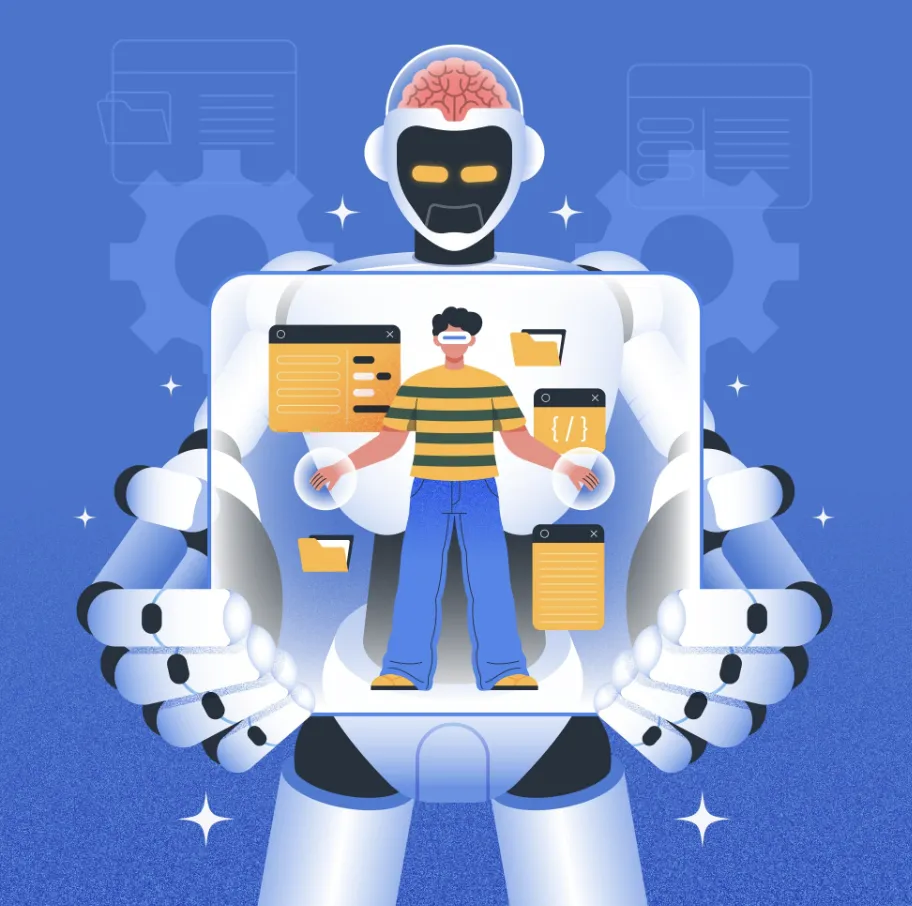What Are AI Agents? Complete Guide for Beginners
Learn what AI agents are, how they work, and their real-world applications. Complete beginner's guide to autonomous AI systems.
AI agents are autonomous software systems that can perceive, plan, and act independently to achieve specific goals. Unlike traditional chatbots, they don't just respond - they take action.
These intelligent systems are transforming industries by handling complex tasks with minimal human oversight. They can manage customer service, automate business processes, and even write code.
Modern AI tools are evolving rapidly, making agents more accessible and powerful than ever before.
Summary
- What Are AI Agents?
- Key Features and Capabilities
- How AI Agents Work
- Types of AI Agents
- Tools That Power Agents
- Real-World Applications
- Benefits and Challenges
- Frequently Asked Questions
- Conclusion
What Are AI Agents?
AI agents are smart software systems that work autonomously to complete tasks and achieve goals. They combine artificial intelligence with the ability to take action in their environment.
Unlike regular software that follows fixed instructions, agents can reason, plan, remember, and adapt to new situations. This makes them incredibly versatile for solving complex problems.
Advanced prompt engineering techniques help these systems understand and execute complex instructions more effectively.
Common Examples You Know
Virtual Assistants: Siri, Alexa, and ChatGPT can set reminders, control devices, and hold contextual conversations across multiple interactions.
Self-Driving Cars: These vehicles use sensors to perceive roads and make real-time navigation decisions without human input.
Customer Service Bots: Modern support systems handle complex queries, process returns, and troubleshoot issues automatically.
Core Components
Every AI agent has three essential elements:
| Component | Function | Example |
|---|---|---|
| Environment | Where the agent operates | Web, database, physical space |
| Tools | Available capabilities | APIs, calculators, browsers |
| Actions | What it can do | Send emails, process data, control devices |
Key Features and Capabilities
Modern AI agents possess several sophisticated capabilities that distinguish them from simple automation tools.
Autonomous Decision Making
Agents analyze information, identify patterns, and make informed decisions without constant human guidance. They can evaluate options and choose the best course of action.
This autonomy allows them to handle unexpected situations and adapt their behavior based on changing circumstances.
Environmental Awareness
Effective agents continuously gather information about their operating environment. They use computer vision, natural language processing, or sensor data to understand their surroundings.
This awareness helps them respond appropriately to changes and make context-aware decisions.
Strategic Planning
Advanced AI systems can develop comprehensive strategies to achieve complex goals. They break down tasks into manageable steps and optimize their approach.
Planning involves identifying necessary actions, evaluating potential obstacles, and choosing optimal methods to reach objectives.
Continuous Learning
One of the most exciting capabilities is self-improvement through experience. Agents learn from successes and failures, refining their performance over time.
This learning ability makes them increasingly effective as they encounter more situations and gather feedback.
How AI Agents Work
Understanding agent functionality requires examining their core architecture and operational processes.
The Foundation Model
Most modern agents use Large Language Models (LLMs) as their "brain." These models provide understanding, reasoning, and response generation capabilities.
Additional components enable reasoning and action beyond simple text generation, creating truly autonomous systems.
Essential System Components
Memory Systems: Agents use multiple memory types to maintain context and improve performance over time.
Tool Integration: External functions extend capabilities beyond the core model, including web search, databases, and specialized software.
Persona Definition: Every agent has specific instructions about their role, personality, and behavioral guidelines.
Operational Workflow
When receiving a task, agents follow this process:
- Goal Analysis: Understanding the request, constraints, and available resources
- Strategic Planning: Creating step-by-step plans and breaking complex tasks down
- Execution: Systematically implementing each step using appropriate tools
- Reflection: Evaluating results and adjusting approach as needed
Types of AI Agents
AI agents can be categorized based on their interaction patterns, complexity levels, and operational scope.
By Interaction Style
Interactive Partners: These agents engage directly with users through conversation and collaboration. Examples include customer service systems and educational tutors.
Background Processes: These operate autonomously behind the scenes, handling automation and optimization tasks like inventory management or network monitoring.
By Complexity Level
| Type | Capabilities | Best For |
|---|---|---|
| Simple Reflex | Basic if-then responses | Predictable environments |
| Model-Based | Internal environment model | Partially observable conditions |
| Goal-Based | Planning and optimization | Complex problem-solving |
| Learning Agents | Continuous improvement | Adaptive scenarios |
Single vs Multi-Agent Systems
Single Agent: One foundation model handles all processing, ideal for well-defined tasks.
Multi-Agent: Multiple specialized agents collaborate, each optimized for specific roles in complex workflows.
Tools That Power AI Agents
The tools available to an agent determine its capabilities and effectiveness in real-world applications.
Knowledge Tools
These help agents gather and process information:
- Web Search: Real-time access to current information prevents knowledge staleness
- Database Connections: Direct access to structured business data through APIs
- Document Processing: Reading and analyzing various file formats and document types
Capability Extensions
These address language model limitations:
- Calculators: Precise mathematical operations for complex calculations
- Code Interpreters: Writing, executing, and debugging code in multiple languages
- Translation Services: Multi-language communication beyond training data
- Media Processing: Analyzing and generating visual and audio content
Action Tools
These enable environment modification and external system interaction:
| Tool Category | Functions | Use Cases |
|---|---|---|
| Communication | Email, messaging, notifications | Customer service, marketing |
| File Operations | Reading, writing, managing files | Data processing, reporting |
| API Integration | External service connections | Business system automation |
| Database Operations | Create, update, delete records | Data management, analytics |
Effective coding prompts can help agents use development tools more efficiently.
Real-World Applications
AI agents are already transforming industries across the globe with practical, production-ready applications.
Customer Service Revolution
Modern customer service agents handle complex queries, access customer history, and process transactions without human intervention. Companies report 80% reduction in response times.
These systems provide 24/7 support with consistent quality, handling multiple languages and adapting to customer preferences.
Business Process Automation
Financial Operations: Agents process invoices, reconcile accounts, generate reports, and handle basic tax preparation while flagging anomalies for review.
Supply Chain Management: Systems monitor inventory, predict demand, reorder supplies, and optimize logistics routes automatically.
Human Resources: From resume screening to employee onboarding, HR agents streamline administrative tasks while maintaining compliance.
Creative and Technical Support
Leading AI tools now generate marketing copy, design materials, and technical documentation based on brand guidelines.
Development agents write code, debug programs, perform reviews, and suggest optimizations across multiple programming languages.
Healthcare and Security
Medical Documentation: Agents transcribe patient interactions, update records, and ensure healthcare regulation compliance.
Cybersecurity: Security systems monitor network traffic, detect threats, and implement protective measures while adapting to new attack patterns.
Benefits and Challenges
Understanding both advantages and limitations is crucial for successful AI agent implementation.
Key Benefits
24/7 Availability: Agents operate continuously without breaks, handling multiple tasks simultaneously across global time zones.
Cost Efficiency: Tasks requiring hours of human work can be completed in minutes, resulting in significant cost savings.
Consistency: Properly configured agents perform tasks with remarkable consistency without fatigue affecting performance.
Enhanced Decision Making: AI-driven systems process vast data amounts quickly, identifying patterns humans might miss.
Current Challenges
Human Interaction Limits: Tasks requiring deep empathy, emotional intelligence, or nuanced social understanding remain challenging for agents.
Ethical Decision Making: Situations involving moral complexity or life-critical decisions still require human judgment and oversight.
Resource Requirements: Sophisticated agents need substantial computational resources and technical infrastructure investment.
Risk Management
Key strategies for successful implementation:
- Human Oversight: Implement "human-in-the-loop" systems for critical decisions
- Continuous Monitoring: Establish comprehensive testing and monitoring protocols
- Clear Boundaries: Define explicit parameters and limitations for agent operation
Frequently Asked Questions
What is the main difference between AI agents and chatbots?
AI agents can take autonomous actions and make decisions, while chatbots mainly respond to user inputs without independent action capabilities.
Do AI agents need human supervision?
Yes, for critical decisions and complex tasks, human oversight is recommended to ensure accuracy and ethical compliance.
What industries benefit most from AI agents?
Customer service, healthcare, finance, e-commerce, and software development see the biggest benefits from AI agent implementation.
Can AI agents work together?
Yes, multi-agent systems allow specialized AI agents to collaborate on complex tasks requiring diverse expertise.
How much do AI agents cost to implement?
Costs vary widely from free tools to enterprise solutions costing thousands monthly, depending on complexity and scale.
Conclusion
AI agents represent a fundamental shift from tools that respond to commands to intelligent systems that understand goals and take autonomous action. They're already transforming industries and creating new automation possibilities.
Success with AI agents requires understanding their capabilities and limitations, choosing appropriate use cases, and implementing proper oversight. Organizations that learn to collaborate effectively with agents will gain significant competitive advantages.
The future of work and business operations is being shaped by AI agents today. Staying informed about optimization techniques and best practices helps you participate in this transformation rather than being surprised by it.

